Last updated on March 8th, 2023 at 05:48 am
Since the first man walked the earth, observed values, vices, and ethos about any group of people at any point in time can be traced back to supernatural entities — gods, devils, angels, demons, and everything in between.
Every culture, from the Romans to the Greeks, the Egyptians, and many others, has a pantheon representing a common element of their polytheistic societies at a given point in history.
Japan, the land of the rising sun, is no exception, with its pantheon expressing much of the country’s historical sense of self.
Japan’s mythology has a rich history that dates back more than 2,000 years. As a result, the influence of the Asian country’s pantheon is noticeable in many parts of its culture.
Even the imperial lineage today is an unbroken line thought to be descended directly from a deity.
From Amaterasu, the Queen mother, to Susanoo, the fiery bull, and Yebisu, the forsaken child, let’s take a look at those major gods that shaped the culture and value systems of what we now know as modern-day Japan.
Here we go!
Izanami and Izanagi – The Primordial Gods of Creation
Izanagi — Izanagi no Mikoto, translated as ‘he who invites’ and Izanami — Izanami no Mikoto, translated as ‘she who invites,’ were the primordial divine beings believed to be responsible for the creation of the earth.
According to records, the brother and sister duo were tasked by an earlier generation of Kamis(divine beings) to bring order to the chaos under the heavenly realm.
Using the divine spear Amenonuhoko, they slashed the first landmass into existence and named it Onogoro-Shima. Onogoro-Shima came as an island and is believed to be the foundation of the new world.
Izanagi and Izanami continued their creation quest in style, slashing the chaotic sea to seed more landmasses into existence, ultimately producing what we now know as the principal eight islands of Japan.
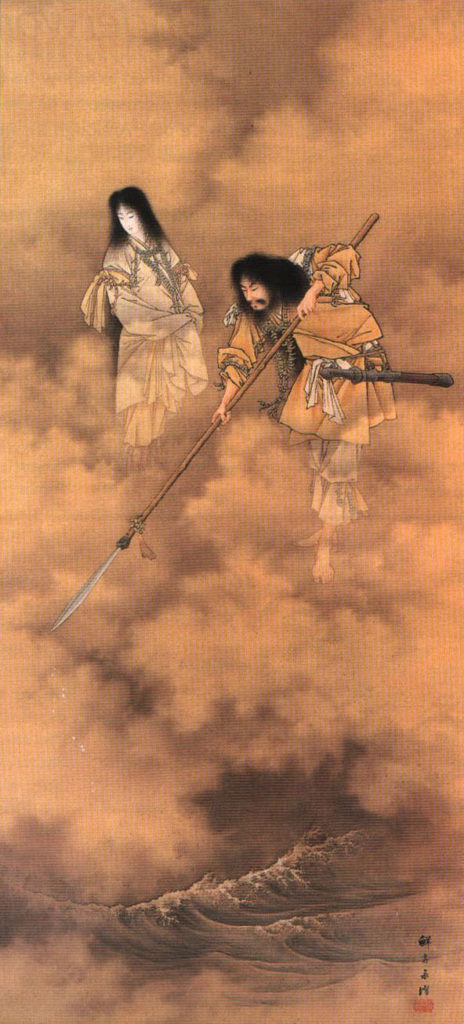
During their creation journey, Izanagi and Izanami got together, and their union resulted in the birth of over 800 Kami. The creation process, unfortunately, has its toll.
Gods aren’t infallible, after all. For example, when birthing the fire deity Kagutsuchi, Izanami passed away from the excruciating pain, and she was subsequently consigned to the afterlife (Yomi).
Grief-stricken, Izanagi tried hard to resurrect his sister Izanami, and he almost succeeded, having convinced the elder gods to let her travel back to the world of the living.
But, ironically, his eagerness led to his failure. Agitated after having to wait too long, Izanagi takes an ill-advised early glance at his sister’s ‘undead’ state. Bad idea. It was a sight for sore eyes; Izanami had become unrecognizable, with her body already rotting and decomposing.
Izanami, furious and humiliated, ordered her devilish minions of thunder kami after him while Izanagi fled in horror and disgust. Finally, Izanagi could barely escape by completely blocking off the entry gateway to Yomi.
To rid himself of the unsavory effects of his last visit to the underworld Izanagi cleansed himself via a cleansing ritual. Izanagi was finally free, but there was a twist.
The cleansing ritual rid him of his demons but also resulted in the birth of new Japanese gods and goddesses known as the Mihashira-no-uzunomiko.
Some of these deities include Amaterasu, the sun goddess, Tsuki-yomi, the moon deity, and Susanoo, the storm god.
Amaterasu was born from washing his left eye, Tsuki-yomi from washing his right eye, and Susanoo from washing his nose. To this end, harai, or purification in Japanese culture, plays a significant role in the ritual before visiting the holy shrines.
Ebisu – The Japanese God of Luck and Fishermen
Hiruko translated as ‘Leach Child,’ is the first child of the primordial god and goddess Izanagi and Izanami. Due to his parents’ transgression during their marriage ritual, he was cursed from birth and was born without bones. Nevertheless, his story is rife with grit, doggedness, and resilience.
According to Shinto narratives, he was left to die in the chaotic seas of the earthly realm, drifting endlessly in the ocean at the young age of three. Despite this mind-blowing ordeal, somehow, Hiruko, as a child, was able to survive, making it a patch of dry land — Ebisu Saburo — in one piece.
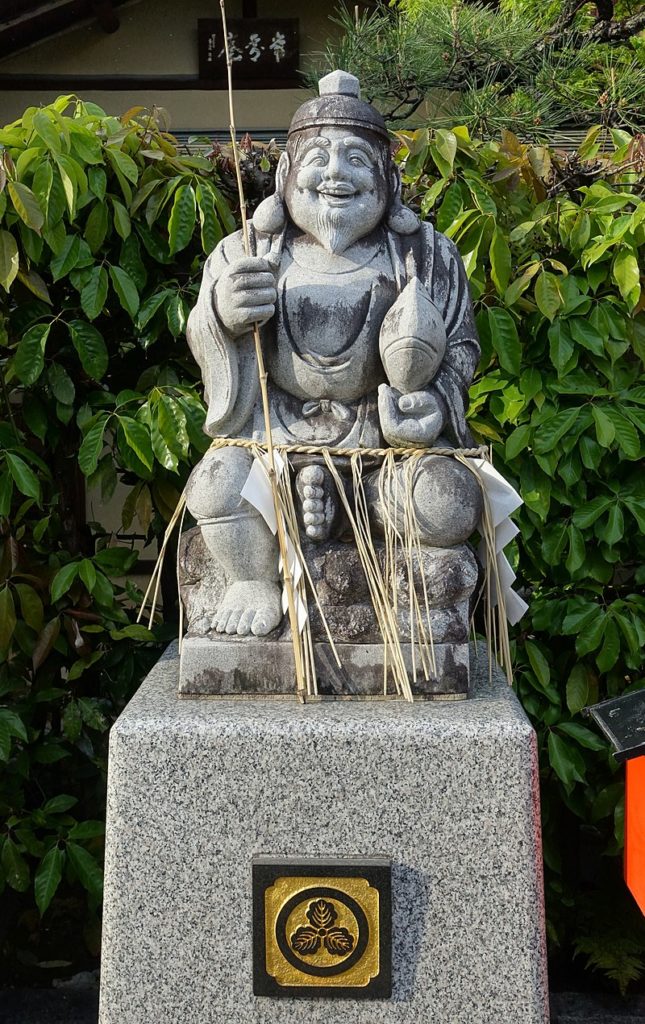
After overcoming numerous challenges, Hiruko renamed himself Ebisu or Yebisu, commemorating his divinity as the patron god of fishermen, children, and, most significantly, prosperity and fortune.
Regarding the latter divine authority, Japanese mythology considers the firstborn god one of the main gods of the Seven Gods of Fortune(Shichifukujin).
Ebisu didn’t let his tragedy and life circumstances define him. He was pictured as a carefree deity with a cheerful disposition (commonly referred to as the “laughing god”). His ensemble is incomplete without the addition of the kazaori eboshi, a center-folded, tall, pointed cap.
Interesting fact: Because of his initial boneless appearance, Eebisu is also known as the deity of jellyfish.
Kagutsuchi – The Japanese God of Destructive Fire
Kagutsuchi, also known as Homusubi, translated as “he who sparks fire,” the fire deity of Japan, is another progeny of the primordial Izanagi and Izanami. He is most well-known for his destructiveness.
His burning spirit tragically scorched his own mother, Izanami, during his birth, causing her to pass away and enter the underworld.
Izanagi, his father, proceeded to cut off Kagutsuchi’s head in a fit of fury and retaliation for causing his sister and lover’s death. Numerous kami were subsequently birthed due to the spilled blood, including battle thunder gods, mountain gods, and even a dragon god.
In simpler terms, Kagutsuchi was revered as the ancestor of numerous strong and formidable deities. His flames were said to have even inspired Japan’s iron and weaponry development.
In terms of history and culture, Kagutsuchi being the god of destructive fire, one that killed his own mother at that, was understandably seen as a potential harbinger of fiery destruction to the Japanese structures that mostly comprise wood and other flammable materials.
In the Japanese Shinto religion, he is the subject of various ceremonies to appease him, one of which is the Ho-shizume-no-matsuri ceremony, an imperial tradition intended to fend off Kagutsuchi’s negative effects for six months.
Amaterasu – The Japanese Goddess of the Rising Sun
Amaterasu, also known by her honorific title hirume-no-muchi-no-kamin, literally translated as ‘the great sun of the kami’ is the Japanese goddess of the rising sun and the ruler of the kami realm, otherwise known as Takama no Hara. Her name comprehensively translates to ‘the splendid kami who lights from heaven.’
Amaterasu is one of the Mihashira-no-uzunomiko, born of the purification of the primordial god Izanagi’s left eye.
Her divine authority as the queen of the kami (leader of all divine beings) was subsequently bestowed upon her by Izanagi. The goddess of the rising sun embodies the grandeur, order, and purity of the rising sun in tandem with her divine attribute.
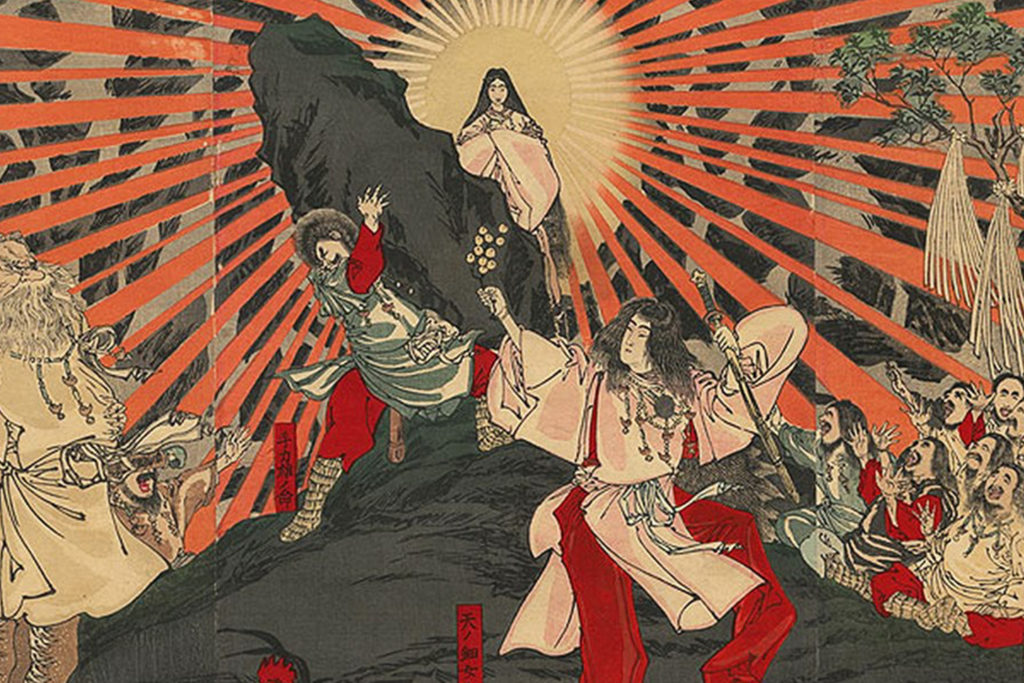
Her position in the Japanese pantheon is of no equal. Japanese mythology tells a story of a time when the world was covered in darkness, losing her radiant aura (symbolic of the irradiant sun) after she disappeared. This occurred after she had a severe altercation with Susanoo, the storm deity, and shut herself inside a cave.
Only after a string of amusing diversionary tactics and practical jokes devised by the other Japanese gods was she persuaded to exit the cave, which once more brought about the appearance of brilliant sunlight.
Regarding cultural ancestry, the Japanese Imperial dynasty is allegedly descended from Ninigi-no-Mikoto, a grandson of Amaterasu who was allowed to rule the earth by his grandmother.
Tsukiyomi – The Japanese God of the Moon
Diametrically contrasting many western mythologies, the Japanese pantheon’s moon deity is no fair maiden but a male Mihashira-no-uzunomiko born for primordial Izanagi’s right eye purification.
Tsukiyomi no Mikoto, or simply Tsukiyomi, holds divine authority over the moon. Some myths claim that he was created from a white copper mirror that Izanagi held in his right hand during his cleansing ritual.
After marrying his sister Amaterasu, the sun goddess, their divine authorities converged, resulting in the union of the sun and moon in the same sky.
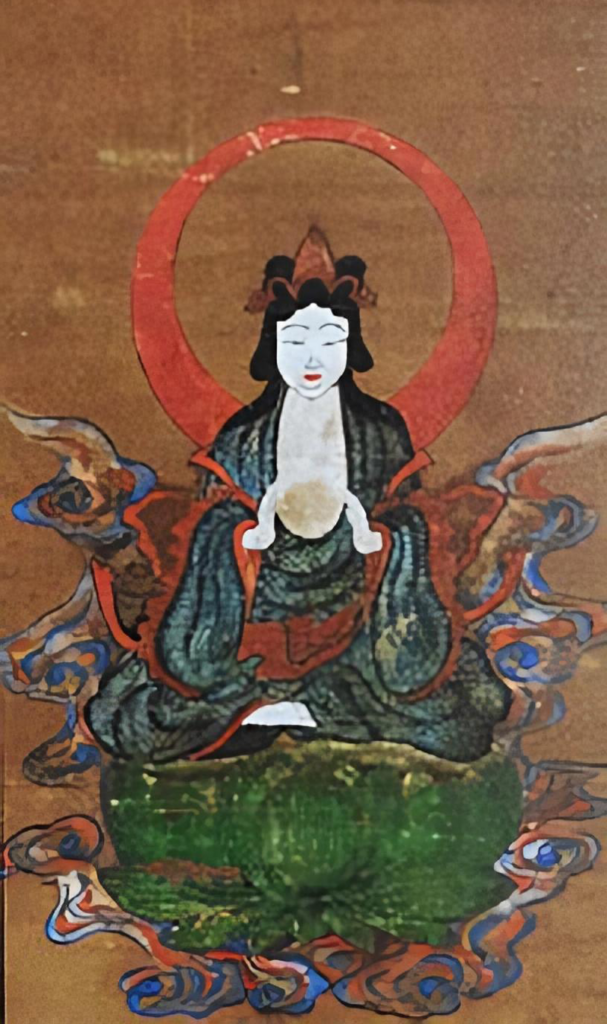
However, the killing of Uke Mochi, the goddess of food, by Tsukiyomi eventually ended this electrifying union. The moon deity supposedly did the heinous act in displeasure after witnessing Uke Mochi spew out numerous foods.
In light of their break up, Amaterasu split with Tsukiyomi and moved to a different area of the sky, ultimately separating day and night. Talk about family drama!
Susanoo – The Japanese God of Seas and Storms
Brother to Amaterasu and Tsukiyomi, Susanno is the third and last Mihashira-no-uzunomiko. He descended from the nose of Izanagi, naturally gifted with control over the domain of the stormy seas.
Susanoo is unique amongst the Mihashira-no-uzunomiko and the Japanese pantheon in general due to the symbiotic relationship between his personality and his divine authority.
As you might already know, storms are typically very violent and ever-changing. The same can be said of Susanoo’s temperament.
According to mythology, his temperamental personality serves as fuel to fire up his control over chaotic storms. The storms, a core part of his divine attributes, also affect his mood and personality.
Whenever Susanoo is moody, the storms rage, and the more the storms rage, the higher his emotions fluctuate. So his rage fuels the storms, and the storm fuels his rage.
This creates a cycle where Susanoo can technically get infinitely stronger in battle, making him one of the strongest gods in the Japanese pantheon.
In Shinto mythology, Susanoo is frequently praised as the upstanding hero who drank alcohol from the ten heads of the wicked dragon (or monster snake) Yamata-no-Orochi after beheading it, so to speak.
After the battle, he could reclaim the renowned sword Kusanagi-no-Tsurugi and win the woman’s hand whom he had saved from the evil dragon’s clutches.
Alluding to the chaotic nature of the storm god, mythology also tells the tales of Susanoo’s malevolence, especially regarding his rivalry with Amaterasu, the sun goddess and the queen of the gods.
One time, their confrontation turned sour when Susanoo, due to his chaotic nature, lost control and went on a rampage. He destroyed Amaterasu’s rice fields and even killed one of her servants.
Enraged, Amaterasu withdrew into a cave, locking her divine light away with her casting all the realms into darkness. Susanoo, on the other hand, left heaven, never to return.
Raijin and Fūjin – The Japanese Gods of Weather
Rajin and Fujin are powerful kami that wield control over the natural elements. You can think of them as the two opposite sides of a coin, yet the same entity. As a result, they can be either sympathetic or uncaring toward the fate of mortals, an undesirable caveat thanks to their divine attributes.
Rajin has authority over lighting and thunder. According to myths, he calls down lighting with the swing of his divine harmer and heralds the booking sound of thunder with every beat of his drum.
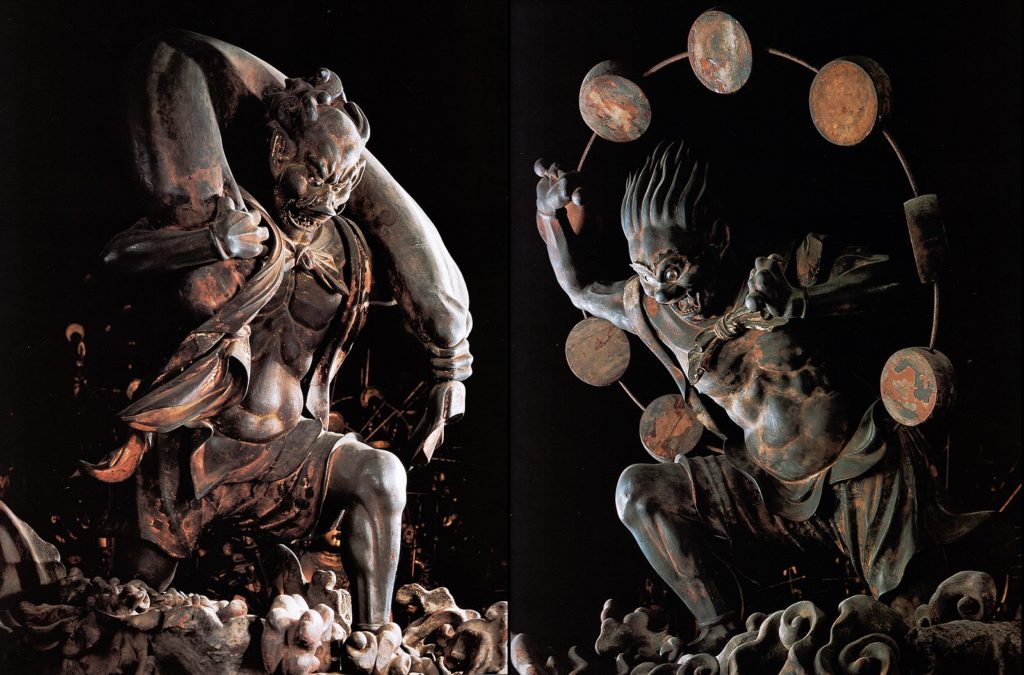
Intriguingly, Raijin is pictured with three fingers, each representing the past, present, and future.
Fujin, on the other hand, is the divine being in control of the winds. Mythology describes him as a monstrous kami who travels the nine realms on gusts of wind as his footstool and wreaks havoc with wind gales.
A few urban legends claim that Fujin saved Japan from the Mongol invasions by releasing the kamikaze (‘divine wind’), a typhoon that wiped out the invading fleets.
Together Rajin and Fujin have complete control over the earthly realm’s weather, holding the fate of all mortals in the palm of their hands.

